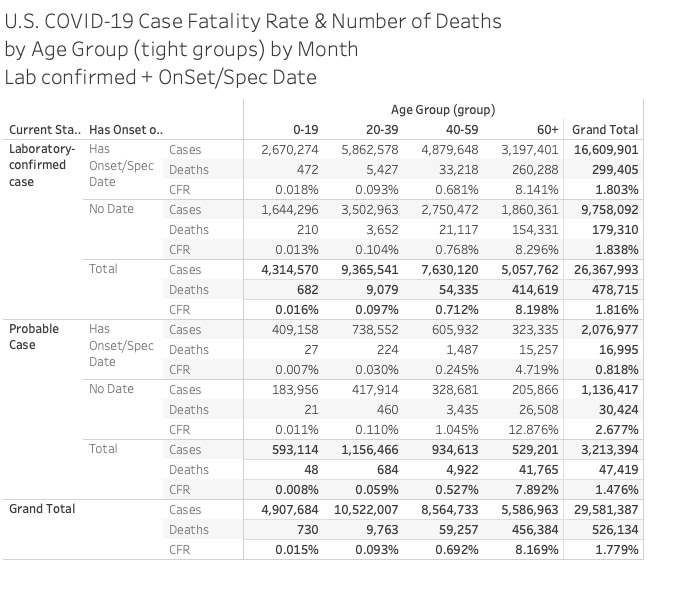The CDC isn't altogether feckless. If you know how to parse the data - you can get to some interesting details. The parsed CFR rate tells a very interesting story.
This infamous Case Fatality Rate stat (CFR) has driven many-an-analyst crazy. Even Dr. Fauci infamously messed up his CFR/IFR jargon in front of congress - which may turn out to be the most fateful mistake ever. (More on that here).
Today, we’re going to whittle down the CDC Case Surveillance File and take a look at a particular subset of data which tells a very interesting tale.
First, here are the raw CFR rates for specific age groups over the course of the pandemic. (If you’re a bit lost - go take a look at our primer for the Case Surveillance File). A reminder, CFR is total deaths divided by the total confirmed cases. Here it is over time for our “tight” age groups:
As you can see the 60+ age group dominates the scene as we might expect given that the median age of death is about 80 years old. Notice the precipitous drop in the CFR as we near the present day. The most recent data will increase as more reports are processed.
One big problem with this chart is that a BIG portion of the drop might be attributed to the MASSIVE increase in testing since the new year began. The more cases you find with oversensitive PCR tests the most skewed these numbers become.
The Discovery!
I’ve tackled this next approach before but not for a long while. Twitter user Zach Bush - one of our OG Rational Ground associates - encouraged me to parse the CFR using some dimensions in the Case Surveillance File.
For example, the file allows you to separate cases based on “Current Status” - either “Lab-confirmed case” or “Probable case.” In many instances either the hospital never had a chance to test someone for COVID or the symptoms were logged retroactively. Another clue are two date fields: “Onset Dt” and “Pos Spec Dt.” Respectively, these fields denote when the symptoms first came about (a standard Epidemiology 101 dimension stat) or when the positive test came back. Either one of these would denote a significant improvement over including just everything and help ward against CFR stat problems for over-testing.
So, here we go… same chart only this time we include JUST cases with a confirmed positive test AND they have a valid “Onset Dt” OR a “Pos Spec Dt.”
Now that is interesting. First, this conforms to what we are seeing with excess deaths with the 40 to 59 age group experiencing a summer increase. More interesting still is that the 60+ age group CFR actually went UP after the vaccine efforts started kicking in.
The difference in totals:
Probable deaths accounted for over 47K deaths (those are excluded in the chart above)
Deaths with no Onset or Pos Spect Date accounted for over 209K deaths
So the current chart accounts for 16,609,901 cases and 299,405 deaths. In truth, as we noted previously, this would be the apples-to-apples comparison number we would use based on how they count influenza numbers - a positive specimen and a date associated with the disease (not the reported date).
Here are the full stats so you can see what was included and excluded:
Curiously, the CDC has not released a TON of updated data for September in their latest October 1st Case Surveillance File. Lots to digest here… I’m open for your thoughts on this. One more table… this one is the data behind the revised line chart. Lab-confirmed + with a valid date by age and month. Deaths and CFR





